When I was a kid there were these VHS videos you could order like “Marty Stouffer’s Wild America: Dangerous Encounters.” Later the Fox Network would go on to produces shows like “When Animals Attack.” The latter were essentially snuff films couched as nature documentaries. The viewer would be treated to grainy security camera footage of a man being kicked in the face by a moose or a lion attacking a safari truck, as a breathless narrator gave you a play-by-play of the mayhem. Maybe for how tactless those films were, they might have had a positive effect. For it seems now that people are forgetting that wild animals can be dangerous.
Tag: Safety
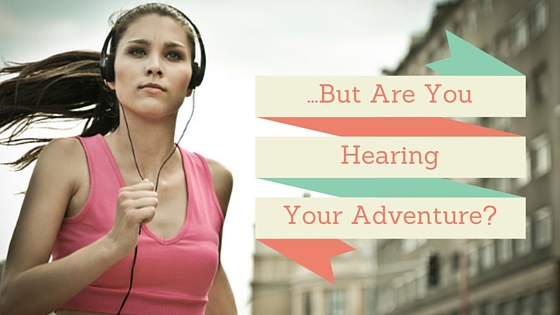
Popping in earbuds and going for a run seem to go hand in hand. A great up-tempo playlist will keep you cranking out the miles at a solid pace. I know that I really enjoy bombing down a technical hill while listening to the bombastic melodies of The Shell Corporation or Billy Talent, but on those runs am I really connecting with the natural world?
In the running community, the headphones debate will rage on for all eternity (or until implants replace headphones). I definitely see the merits of both sides of this debate because I have rules for whether or not a run is a headphones run. For me if I am running somewhere new, then I will definitely not wear headphones. Not only does it help me feel as if I am truly experiencing a place, but also it makes me more receptive to what is going on around me.
When I was visiting Portland, Oregon a few months ago I went for a short pre-dawn run (Like 4 a.m. pre-dawn) and started to enter an unlit park. As I started winding up a hill I started hearing voices and laughter coming from ahead of me. I stopped and moved into the shadows of some trees and waited. The laughter continued, like in a horror movie, but I could not exactly pinpoint where it was coming from ahead of me. Ultimately, I could not decide if those ahead of me were a threat or not so I turned and silently jogged back towards the lighted city streets. If I had been listening to my headphones I would have probably ran right into whoever was out there ahead of me.
I do listen to music though when I run around my neighborhood or when I’m alone in Umstead State Park. These places are familiar to me and I relatively know what to expect around each turn. For me these are the times when I experience the music the most, my mind focuses on the lyrics and the arrangements. It is during these runs that I use the music to tune out the monotony of a run I have repeated so many times (or road running).
One place I do not believe headphones should be is in trail races. I know, “run your own race”, but to me, it’s skipping out of a part of the race. The toughest battle you face on a run is in your head and music is tuning that out. I am not putting music in the same category as PEDs, but in my opinion, you are not facing the entirety of the run.
Another thing is you are shutting yourself out from meeting new and interesting people. The one thing I tell people about the trail and ultra community is that it is made up of some of the best people. I know one of my favorite parts of racing is getting to meet the people you are pacing with. I like hearing where people are from, why they run, and how they got here. I see us as a small interconnected community, so I value when I get to meet people of my same tribe. This is also the place where I can talk about my passion for ultra running without coming off as a bragging or getting asked the typical mental health screening questions that non-runners like to ask.
Finally, I’ve seen people blow through aid stations with their headphones on and “forget” to thank the race volunteers. DO NOT BE THAT PERSON! The volunteers having given up their weekend to support us and if you cannot be bothered to thank the volunteers then you don’t need to be out there. These people are as bad as those who blast music from a Bluetooth speaker as they run, go run a Rock & Roll Marathon you’ll fit in better there.
Sorry, it turned into a bit of a rant but I guess I have some strong opinions on this topic. Also after reading one of Mid-Pack Zach’s rants I was kind of inspired (he has a great running blog). Thank you for reading and feel free to comment with your opinion.

I have been dealing with a self-induced case of the Noravirus over the last two days and it has been awful! It is also a bit timely, as I have been planning on doing a rundown of some diseases and ailments that you can encounter on your adventures in the wilderness.
Giardia: What do I do now that I’ve read through all my Outside magazines?
Giardia is a waterborne parasite that comes from fecal matter. Giardia is fairly resilient which makes it more dangerous. The parasite does well in cold weather and is resistant to many disinfectants. For this reason, water filtration is always a better choice than chemical treatment. Once Giardia is consumed and enters your body it begins to multiply. The infection often causes diarrhea, which can lead to dehydration. The disease takes 7-10 days for incubation and can typically last for 3-4 days. If you believe you may have contracted Giardia you need to contact your healthcare provider.
Lyme Disease: Is there a target on my back?
Lyme disease is a bacteria spread through tick bites. The first symptoms can appear anywhere between 3 to 32 days after the bite. These first symptoms include feeling tired and body aches, so feeling old and worn out from your adventure. The biggest telltale sign of Lyme disease is if you develop the Target Logo on our body in the form of a rash. The disease can be treated but the longer treatment is delayed the more severe the disease can become, leading to cardiac anomalies, joint pain, and neurological symptoms.
Botulism Poisoning: What I was poisoned by cosmetics?
Botulism poisoning is caused by the bacteria Clostridium botulinum (it is related to Botox, but they are not the same thing). The reason that this disease is relevant is because it is prevalent in canned and packaged foods. It can easily be prevented by bringing the food up to boiling temperatures. Botulism has a short incubation period from 12 to 36 hours. The symptoms start as blurred vision and then go on to cause paralysis throughout the body. Botulism must be treated with an antitoxin so immediate medical treatment should be sought. The more rapidly the symptoms onset is the higher the potential for being fatal.
Salmonella: Does this mean I’m at a greater threat of being eaten by a bear?
Salmonella is one of the more common food poisonings and people across the world are affected by it every day. Salmonella commonly presents as nausea, vomiting, diarrhea and cramping. Often times a healthy person is able to fight off the infection after a few days, but sometimes antibiotics are required. The reason I mention this is because when traveling in the backcountry it can be hard to maintain optimal cleanliness and hygiene. For these reasons, you should make sure to thoroughly cook your food and boil your water. The backcountry is not the best place to try making Chicken Tartare.
Did I get anything wrong? Is there a disease that I should have covered that I didn’t? Let me know in the comments section. Thank you.
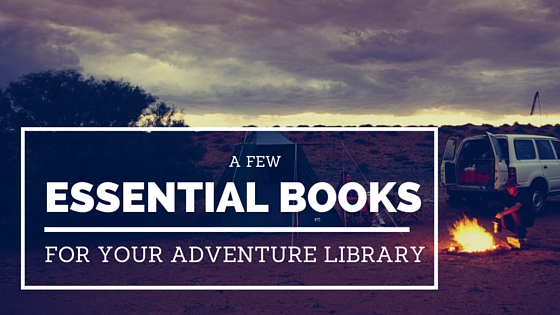
When you are passionate about something you tend to collect everything said or written on the topic. Here I have compiled my top four books that cover a variety of fields that an adventure seeker should be familiar with.

The Complete Walker IV: When I was 18 or 19 years old I was a student at Penn State Mont Alto, which is right next to the Appalachian Trail. It did not take long for me to become infatuated with the trail and the people who walk it. So as I began to obsess over it, a mentor of mine, Rodney, made sure to put this book in my hands. He explained that it was the bible for backpackers and would tell me everything I need to know. The book, which is written by experienced outdoorsmen Colin Fletcher and Chip Rawlins, breaks down almost every aspect of backpacking. Some might be surprised that it takes 864 pages to explain putting your stuff in a bag and then putting one foot in front of the other repeatedly, but the authors do not want their readers to be uninformed.
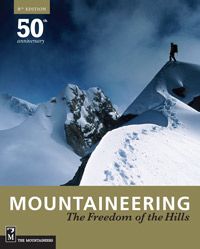
Mountaineering: Freedom of the Hills: If you could earn a college degree in standing atop the world, then this would be your textbook. Unlike many textbooks, this one is not some overpriced scam but a well-written textbook with excellent illustrations. This book condenses the knowledge of some of the most experienced mountain men and gives it to you in an easily digestible content. Even if you do not plan to summit Aconcagua, this book has valuable information for all those who enter the realm of mountains. Knowing how to read the terrain, weather and conditions are really important because, in the mountains, dangers are amplified.
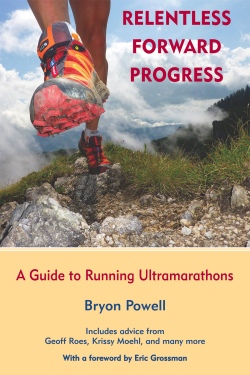
Relentless Forward Progress: Before I met my friend Ben, who became my ultra running go-to guy for questions, there was this book. Bryon Powell is the founder and editor of the website I Run Far and has made a career out of running ultras and covering ultra races. He is also an excellent example of someone who has made what they love into a career as he went from being an attorney to a running coach and journalist. In this book, he breaks down the science of running and includes essays from elite ultra runners in what works for them. He also outlines great training plans for a multitude of distances. I myself used his training plan when I ran the Leatherwood Ultra 50-miler.
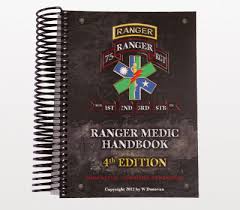
The Ranger Medic Handbook: This is the most expensive book on the list but also the most valuable in my opinion. This book is densely packed with lifesaving information. While it is geared towards a highly trained Army Ranger Medic, it is laid out in if-then-style flowcharts on how to evaluate and treat a casualty. While I hope your adventure does not include injuries caused by bullets or landmines, it also has practical information on how to treat fractures, concussions and variety of ailments you can encounter in the backcountry. Not only does it tell you the hands-on treatments for them, but also the correct medications and dosages for these injuries and diseases. Note: A few years ago there was a fake version of this book in the Kindle store and had bad information in it. Amazon has several versions of this book in different formats. I have included the link to the North American Rescue Products version, which is the version issued by the U.S. Army. The fact that this version is spiral bound and printed on more durable paper means it can stand up to the hardships of your adventure.
So those are the four books I recommend the most when asked about adventure. Did I miss any? Do you have any suggestions for future reading? Please comment if you do.

The air begins to cool as the sun begins to go down and you are not exactly sure about where you are. Maybe the mental note of ‘turn left at the downed tree with the squirrel on it’ was not your best moment. Now you are starting to even question whether it was a grey, red or one of those mutant black squirrels (seriously look it up). Now you shiver and you regret leaving that hoodie in the car. It is right about here you first ask yourself the question, “Am I lost?”
You probably are not, you just need to take a moment to calm down and figure out where you are. This is the time to sit down and take a moment and think rationally about it. This will help prevent you from doing something to get yourself into real trouble.
According to Boy’s Life Magazine (the Foo Fighter’s least favorite magazine), you should follow the acronym S.T.O.P.
- Stop: Just stop moving, getting more lost will not make it easier to get found.
- Think: Take a moment to think back on how you got to this point and look at the map if you have one.
- Observe: Look around and assess if anything is familiar. Maybe you can see the parking lot from there.
- Plan: Come up with a plan. If you want to look over the next hill to see if you find something you recognize, make easily distinguishable markers to at least get you back to where you are now. Do not keep wandering around hoping to find your way out.
So now that you have admitted that you are lost it is time to figure out your next steps. You are at a critical point where you must decide what you do next. Does someone expect you back? Will they notify help if you do not return tonight? Do you have the resources to spend the night? Approximately how much daylight do you have left? Do you have food and water?
If you know someone is expecting you back at a certain time and you know they will notify the authorities, then you need to hunker down. You need to face the possibility of being out there the entire night. That means get out of the wind, build a shelter that helps keep body heat in, and conserve what remaining resources you have.
Do not drink unfiltered water unless it is a life or death situation.
Do not camouflage yourself and your equipment (unless you are being hunted by a predator).
Attempt to remain in your current location through the night and as long as possible into the next day. If you have to move or choose to move make sure to mark the route with obvious signs that rescuers can follow. Arrange rocks into arrows, break fresh tree branches or arrange things in a way that will tell people that someone recently passed through the area.
Ultimately the best thing to do is wait for help, moving around only makes it harder for rescuers to find you.
And as always, remember the words of Douglas Adams, “Don’t panic!”
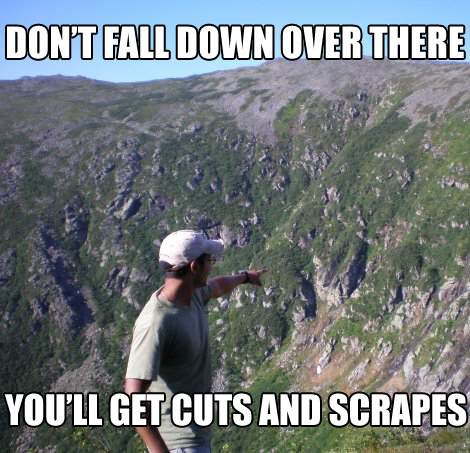

Merriam-Webster defines adventure as, “an exciting or dangerous experience”. So it’s not ridiculous to say that most adventures push your limits. That’s the point of an adventure, to get out of your comfort zone and say, “I can do this!” That said, there is also knowing where your limits are and the responsibility to not needlessly take risks. The reason is that when you call for help, you are asking someone else to put his or her life on the line for you. In mountaineering, there is something called the “death zone”, a place where if something bad happens to you, it is a death sentence.
This isn’t to say you should not push your limits. The above picture shows Sue Austin, a woman who has been challenging ideas about what it means to be handicapped. Sue has looked at the world around her and said how can I show that I’m not a prisoner of a wheelchair. The wheelchair is just her vehicle to see the world.
She worked with engineers and experienced divers to devise a system in which she could use her wheelchair on a deep-sea dive. She then went where many people in her position would never think of going. What Sue did was push her limits while working to mitigate risk.
I am not trying to discourage the budding adventurist because I have taken my share of dumb, needless risks. I just want to encourage people to plan, prepare and analyze their proposed adventure. We live in a world where safety equipment and features are built into most aspects of our lives so it is easy to lose sight on what real risk is.
One of the deadliest years on Mount Everest since 1996 occurred in 2014. A problem that kept re-occurring on Everest was the amount of novice climbers who booked trips with discount outfitters. The novice climbers saw this as a guided trip to the summit of the highest mountain on Earth. They in no way were prepared for the physical stamina required to make the climb or what to do when things went wrong. The outfitters were prioritizing getting their clients to the summit over doing it safely. Fortunately the government of Nepal has stepped in and placed more controls on who gets to attempt Everest.
I leave you with this, go out and explore and experience. Just do it wisely, not foolishly.
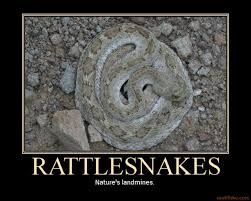
You are scrambling over some rocks while out on your adventure when you jump down only to be met with a sudden stinging pain and a chorus of tiny maracas. You have been bitten, but unfortunately for your girlfriend you won’t become a sparkly, moping vampire, you will begin to develop necrosis (the death of skin and muscle tissue cells around the bite area).
So what are you to do now that you’ve been bitten? First move away from the snake. The snake bit you because he felt threatened, not because he thought you would taste delicious.
After moving away, remember this next step through the rest of our snake encounter. In the words of the great Douglas Adams, “Don’t panic!”
A lot of old timers will tell you that you need to kill or capture the snake to bring with you to the Emergency Room. This is as bad as drunkenly texting your ex at 3am. The thing is they estimate that 20-25% of pit viper (rattlesnakes, copperheads) and 50% of coral snake bites are dry bites (the snake does not use venom). So chasing a snake around is sure to increase the likelihood that it will use venom. Just note the description of the snake and stay away. In North America there is only one type antivenom that treats bites from rattlesnakes, copperheads and cotton-mouth/water moccasins. The only outlying snake would be the coral snake.
Do not attempt to “suck” the venom out of the bite. While this makes for an entertaining comedy trope, it is not accepted first aid.
Some more old practices that we now know to be bad are:
- Do not put ice on the bite.
- Do not try to “bleed” out the poison by cutting between the fang marks.
- Do not use alcohol.
- DO NOT TOURNIQUET THE AFFECTED LIMB!
What you should do is remove anything that can become constrictive in the event of swelling (things like rings).
Attempt to immobilize the bitten area without constricting the flow of blood. Seek immediate medical attention from the local Emergency Room.
Remember throughout the event the key is to remain calm and don’t panic.

If you intentionally own two or more pairs of Running Shoes, then you probably know who Caballo Blanco is. Caballo Blanco is the nickname of ultra running legend Micah True whom went on to become the mystical central figure of Christopher McDougall’s book “Born to Run”.
Micah True lived a life without materialism and in pursuit of passion. With the decision to eschew a normative American life he developed a bit of a following not unlike that of Christopher McCandless. For a man who lived a fairly private life this lead to complications but also the ability to use his celebrity to further causes he cared about, like protecting Copper Canyon in Mexico. Unfortunately, just as he spend a large portion of his time running alone through the mountains his life would end the same way.
On May 27, 2012 True left the Wilderness Lodge in the Gila Wilderness, part of the Gila National Forest in New Mexico, for a 12-mile run. After he failed to return to the lodge a large search and rescue operation was launched in an attempt to locate him. On March 31st, after searching a 200,000-acre area, they finally found his body alongside a stream. True had died from complications related to a heart disorder.
Could True have been saved? That is something we will never know, but what we can learn from it is the importance of notifying people as to where you are.
When I was younger I used to go solo hiking all the time, and I would often write up my where I was and my proposed route and when to contact help if I had not returned. I would then tape it to my roommate’s door and begin my adventure. Fortunately I never needed assistance but at least rescuers would not waste valuable time searching other areas.
Aron Ralston famously gave a vague description of his weekend itinerary in Utah and found his arm pinned under a boulder in a canyon. While searchers looked elsewhere, Ralston was forced to cut his own arm off to escape the predicament.
Today it is even easier to let people know you need help. There is a great app called Bugle. This app allows you to put in your important information, such as where you are going and when you plan to return. If you do not check in with the app in time it will automatically send alert notifications to your emergency contacts telling them they should check in with you and where you said you would be. The app is free so there are no excuses for an adventurer to not use it.
So unless you enjoy drinking your own urine or you’ve always wanted to attempt a major surgery on yourself, tell someone where you are going.
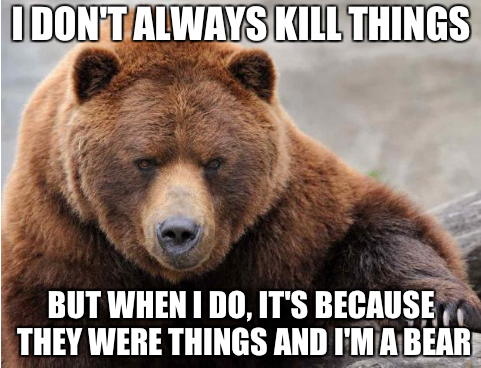
It’s all fun when you are kicking it with your friends and beers, but it’s never fun and when you are kicking and screaming with your friends and bears. So here are some basic bear safety tips.
Introduction:
I think bears are about one of the coolest animals in North America. The Grizzly and Kodiak bears are badass apex predators that put mankind in check. There is a majestic feeling that comes from being in their presence, maybe its because we’ve gotten too comfy at the top of the food chain and that reminder that there are other creatures that can rip us apart without hesitation excites us. Maybe it’s because most of us spent the first few years of our lives carrying around a Teddy Bear everywhere we went. I do not know the real reason but one must tread lightly when dealing with bears and respect them.
Safety:
1) Make Noise: Do you like it when someone sneaks up on you and surprises you? Now imagine that you are an 800-pound creature who is guided by their amygdala. It’s fight or flight and your opponent is half your size. Making noise will tell the bears that you are in the area and typically they will avoid you.
2) Stop playing with dead things. Remember that time your sibling/roommate ate the last piece of cake that you were thinking about all day. Initially you probably thought of smashing something heavy over their head and then the rational side of your brain kicked in and you did not have time for a trial and lengthy prison stay. Well bears are not constrained by a penal code so when you impede on their food, they will defend it, but unlike an angry roommate you cannot talk your way out of this one.
3) Do not bait in the bears. Bears have a great sense of smell and will scavenge food. So pack out your trash. Also when in bear country, store your food in a bear bag and hang it away from your camp. Remember you are in the bear’s house, not your house.
4) Take Robert Rodriquez and Quentin Tarantino’s advice and be extremely weary from dusk till dawn. Bears are large, furry mammals so during the summer months they tend to be fairly inactive during the day and more active at night. So when in bear country attempt to do most of your traveling during daylight hours. This also improves your chance of spotting a bear before they see you.
5) STAY ALERT, STAY ALIVE! The problem with bears is that they live in some of the most beautiful areas of North America, so if you visit these areas you must tread lightly. Remember you are in nature to experience it so unless you want the latest album from The Weekend to be the last thing you ever hear, take out the headphones and pay attention.
6) DO NOT RUN! Seriously, move away cautiously, but do not run away. Bears are like cops in that way. If the police roll up and you run away you look guilty and in need of chasing.
As an avid adventure seeker I have found myself in many misadventures. While they can leave with you better memories than the intended adventure, they can also leave you seriously injured or with a one-way ticket off this mortal coil. So what I want do is use real world incidents to Monday-morning-quarterback what was done well and what could have been done to prevent, avoid or get out of the situation.
This blog is in no way intended to ridicule or denigrate the parties involved. This is an attempt for us to learn and hopefully prevent future disasters. Also while I will make every attempt to fact check the advice I give I realize that I am not infallible. If you notice misinformation please send me a correction with your source so I can correct it.
Also if you want me to answer any questions or have content that may be of interest to the blog please leave it in the comments section.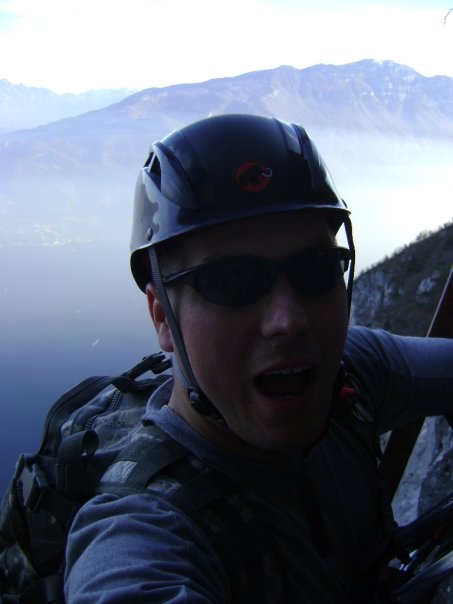
Thank you.
Recent Comments